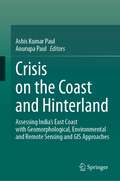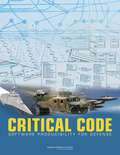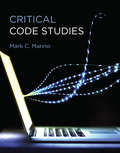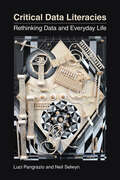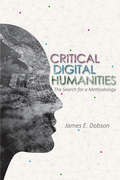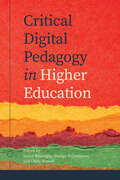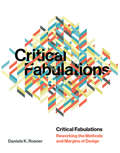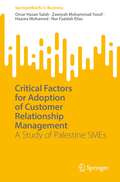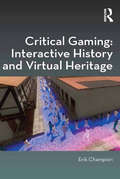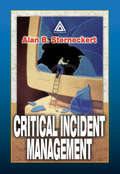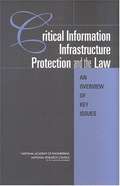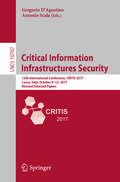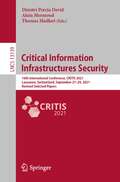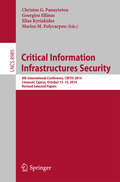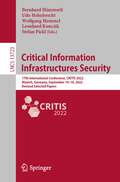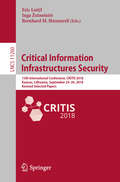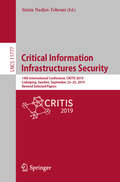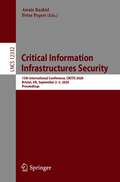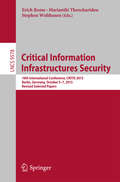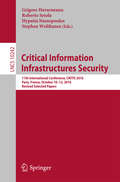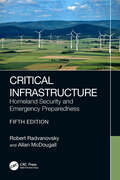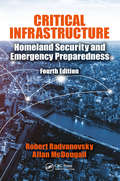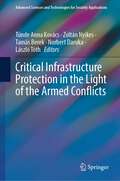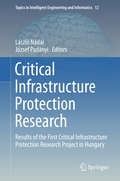- Table View
- List View
Crisis Communication in a Digital World
by Mark Sheehan Deirdre Quinn-AllanCrisis communication in a digital world provides an introduction to major crisis communication theories and issues management, using practical examples from Australia and New Zealand. The book examines how public relations can influence the nature of a crisis and the impact of its aftermath. It explores the role of PR specialists in different crisis situations - including natural disasters and morphing crises - and examines the challenges they face in a world where social media is a key source of communication. Readers are provided with an in-depth understanding of crisis communication and issues management through practical approaches, strategies and skills, which are supplemented by relevant theories based on evidence and experience. International perspectives have been included throughout to illustrate the impact of multinational companies on the digital world, including global media cycles and social media activism. Each chapter explores a different aspect of communications, including media, natural disasters and celebrity crises.
Crisis on the Coast and Hinterland: Assessing India’s East Coast with Geomorphological, Environmental and Remote Sensing and GIS Approaches
by Ashis Kumar Paul Anurupa PaulThis contributed volume assesses the state and future of India’s East Coast through a wide variety of chapters grouped by methodology and approach. Part I: Assessment through Geomorphological Approaches describes geomorphological diversities of the eastern shorelines of India, Coastal Modelling System- SMC and morphodynamics of Odisha coast, Paleo shorelines and beach ridge chenier formations of Subarnarekha delta, seasonal sediment budget of Chandrabhaga beachdune system, Beach stage and dune stage modelling Mandarmoni coast, drainage characters of South Andaman Islands, coastal foredune morphology and sediment of Odisha and West Bengal, Geo-archaeological pieces of evidence of ancient coastal environment, coastal sediment characters, beach ridge formation in the chenier coast, and geomorphological changes of ancient ports and harbours in the shoreline of West Bengal. Part II: Assessment through Environmental Approaches addresses various environmental assessment techniques of mangrove sensitivity to the sea level rise process in the Sundarban, land degradation of the hinterland drainage basins, the riparian environment of the coastal drainage basins, agricultural adaptability in response to climate variability in the coastal areas of West Bengal, forest degradations of the lateritic upland tracts, coastal tourism potentialities in Odisha and West Bengal, Climate variabilities and agricultural modifications in the hinterland areas of West Bengal districts, the tidal flat environment of Sagar Island, landforms and Geomorphosites for the promotion of Geotourism in South Andaman Perils of Premature Reclamation of Sundarban, marine litter in the coastal regions of West Bengal and Odisha on flora, fauna and humans, Ground water contamination due to saline water encroachment in coastal Andhra Pradesh and Spatio-temporal changes in the Hugli estuarine environment and coastal hazards and flood risk of southwestern Sundarban. Part III: Assessment through Remote Sensing & GIS Approaches uses the aforementioned techniques in service of exploration of monitoring health of Mangrove forest, Geomorphological analysis of the coral fringed coasts of Andaman, hydrological and morphological variations of Ichhamati Tidal estuary, multivariate analysis of coastal vulnerabilities, geography of tourism resources in Andaman group of islands, tourism climate index with application geospatial techniques, diversity of landscape ecology in the coastal blocks of Purba Medinipur, overwash vulnerability in Odisha coast, livelihood security index of the coastal communities, managing coastal squeeze response and wetland loss in the estuarine coastal tract of West Bengal, environmental effects of historical land reclamation process in the Sundarban, and emerging environmental problems of coastal urbanization in Digha, Kanthi, and Haldia.
Critical Code: Software Producibility for Defense
by National Research Council of the National AcademiesCritical Code contemplates Department of Defense (DoD) needs and priorities for software research and suggests a research agenda and related actions. Building on two prior books--Summary of a Workshop on Software Intensive Systems and Uncertainty at Scale and Preliminary Observations on DoD Software Research Needs and Priorities--the present volume assesses the nature of the national investment in software research and, in particular, considers ways to revitalize the knowledge base needed to design, produce, and employ software-intensive systems for tomorrow's defense needs. Critical Code discusses four sets of questions: To what extent is software capability significant for the DoD? Is it becoming more or less significant and strategic in systems development? Will the advances in software producibility needed by the DoD emerge unaided from industry at a pace sufficient to meet evolving defense requirements? What are the opportunities for the DoD to make more effective use of emerging technology to improve software capability and software producibility? In which technology areas should the DoD invest in research to advance defense software capability and producibility?
Critical Code Studies: Initial Methods (Software Studies)
by Mark C. MarinoAn argument that we must read code for more than what it does—we must consider what it means.Computer source code has become part of popular discourse. Code is read not only by programmers but by lawyers, artists, pundits, reporters, political activists, and literary scholars; it is used in political debate, works of art, popular entertainment, and historical accounts. In this book, Mark Marino argues that code means more than merely what it does; we must also consider what it means. We need to learn to read code critically. Marino presents a series of case studies—ranging from the Climategate scandal to a hactivist art project on the US-Mexico border—as lessons in critical code reading.Marino shows how, in the process of its circulation, the meaning of code changes beyond its functional role to include connotations and implications, opening it up to interpretation and inference—and misinterpretation and reappropriation. The Climategate controversy, for example, stemmed from a misreading of a bit of placeholder code as a “smoking gun” that supposedly proved fabrication of climate data. A poetry generator created by Nick Montfort was remixed and reimagined by other poets, and subject to literary interpretation.Each case study begins by presenting a small and self-contained passage of code—by coders as disparate as programming pioneer Grace Hopper and philosopher Friedrich Kittler—and an accessible explanation of its context and functioning. Marino then explores its extra-functional significance, demonstrating a variety of interpretive approaches.
Critical Data Literacies: Rethinking Data and Everyday Life
by Luci Pangrazio Neil SelwynA guide to everything you need to understand to navigate a world increasingly governed by data.Data has become a defining issue of current times. Our everyday lives are shaped by the data that is produced about us (and by us) through digital technologies. In this book, Critical Data Literacies, Luci Pangrazio and Neil Selwyn introduce readers to the central concepts, ideas, and arguments required to make sense of life in the data age. The authors challenge the idea that datafication is an inevitable and inescapable condition. Drawing on emerging areas of scholarship such as data justice, data feminism, and other critical data studies approaches, they explore how individuals and communities can empower themselves to engage with data critically and creatively.Over the course of eight wide-ranging chapters, the book introduces readers to the main components of critical data literacies—from the fundamentals of identifying and understanding data to the complexities of engaging with more combative data tactics. Critical Data Literacies explores how the tradition of critical literacies can offer a powerful foundation to address the big concerns of the data age, such as issues of data justice and privacy, algorithmic bias, dataveillance, and disinformation. Bringing together cutting-edge thinking and discussion from across education, sociology, psychology, and media and communication studies, Critical Data Literacies develops a powerful argument for collectively rethinking the role that data plays in our everyday lives and re-establishing agency, free will, and the democratic public sphere.
Critical Digital Humanities: The Search for a Methodology (Topics in the Digital Humanities)
by James E DobsonCan established humanities methods coexist with computational thinking? It is one of the major questions in humanities research today, as scholars increasingly adopt sophisticated data science for their work. <P><P>James E. Dobson explores the opportunities and complications faced by humanists in this new era. Though the study and interpretation of texts alongside sophisticated computational tools can serve scholarship, these methods cannot replace existing frameworks. <P><P>As Dobson shows, ideas of scientific validity cannot easily nor should be adapted for humanities research because digital humanities, unlike science, lack a leading-edge horizon charting the frontiers of inquiry. <P><P>Instead, the methods of digital humanities require a constant rereading. At the same time, suspicious and critical readings of digital methodologies make it unwise for scholars to defer to computational methods. <P><P>Humanists must examine the tools--including the assumptions that went into the codes and algorithms--and questions surrounding their own use of digital technology in research. <P><P>Insightful and forward thinking, Critical Digital Humanities lays out a new path of humanistic inquiry that merges critical theory and computational science.
Critical Digital Pedagogy in Higher Education (Issues in Distance Education)
by Suzan Köseoğlu George Veletsianos Chris RowellRecent efforts to solve the problems of education—created by neoliberalism in and out of higher education—have centred on the use of technology that promises efficiency, progress tracking, and automation. The editors of this volume argue that using technology in this way reduces learning to a transaction. They ask administrators, instructors, and learning designers to reflect on our relationship with these tools and explore how to cultivate a pedagogy of care in an online environment. With an eye towards identifying different and better possibilities, this collection investigates previously under-examined concepts in the field of digital pedagogy such as shared learning and trust, critical consciousness, change, and hope.
Critical Fabulations: Reworking the Methods and Margins of Design (Design Thinking, Design Theory)
by Daniela K RosnerA proposal to redefine design in a way that not only challenges the field's dominant paradigms but also changes the practice of design itself.In Critical Fabulations, Daniela Rosner proposes redefining design as investigative and activist, personal and culturally situated, responsive and responsible. Challenging the field's dominant paradigms and reinterpreting its history, Rosner wants to change the way we historicize the practice, reworking it from the inside. Focusing on the development of computational systems, she takes on powerful narratives of innovation and technology shaped by the professional expertise that has become integral to the field's mounting status within the new industrial economy. To do so, she intervenes in legacies of design, expanding what is considered “design” to include long-silenced narratives of practice, and enhancing existing design methodologies based on these rediscovered inheritances. Drawing on discourses of feminist technoscience, she examines craftwork's contributions to computing innovation—how craftwork becomes hardware manufacturing, and how hardware manufacturing becomes craftwork. She reclaims, for example, NASA's “Little Old Ladies,” the women who built information storage for the Apollo missions by weaving wires through magnetized metal rings.Mixing history, theory, personal experience, and case studies, Rosner reweaves fibers of technoscience by slowly reworking the methods and margins of design. She suggests critical fabulations as ways of telling stories that awaken alternative histories, and offers a set of techniques and orientations for fabulating its future. Critical Fabulations shows how design's hidden inheritances open different possibilities for practice.
Critical Factors for Adoption of Customer Relationship Management: A Study of Palestine SMEs (SpringerBriefs in Business)
by Omar Hasan Salah Zawiyah Mohammad Yusof Hazura Mohamed Nur Fazidah EliasThis book explores the challenges in adopting customer relationship management (CRM) models in developing countries, with a focus on Palestine. Examining the cultural, organizational, and technological contexts, it reveals how these factors create adoption gaps, impacting customer pressure, employee engagement, and security. The narrative, enriched by real-world examples from Palestine, underscores the unique hurdles faced by firms in such environments. Emphasizing the central role of customers in business, the book delves into the initiatives many firms take to enhance customer services, target profitable segments, and improve acquisition and retention. However, in developing nations, these efforts encounter distinctive challenges. The book offers a practical CRM model tailored to the specific needs of small and medium-sized enterprises (SMEs), illustrating how technology can elevate competitiveness. With a strategic perspective, it positions CRM as a catalyst for SMEs to navigate the complexities of the dynamic economy, providing actionable insights for professionals, scholars, and business management students. This comprehensive guide encapsulates the nuances of CRM adoption, making it an invaluable resource for those seeking sustainable growth in developing country contexts.
Critical Gaming: Interactive History and Virtual Heritage (Digital Research in the Arts and Humanities)
by Erik ChampionThis book explains how designing, playing and modifying computer games, and understanding the theory behind them, can strengthen the area of digital humanities. This book aims to help digital humanities scholars understand both the issues and also advantages of game design, as well as encouraging them to extend the field of computer game studies, particularly in their teaching and research in the field of virtual heritage. By looking at re-occurring issues in the design, playtesting and interface of serious games and game-based learning for cultural heritage and interactive history, this book highlights the importance of visualisation and self-learning in game studies and how this can intersect with digital humanities. It also asks whether such theoretical concepts can be applied to practical learning situations. It will be of particular interest to those who wish to investigate how games and virtual environments can be used in teaching and research to critique issues and topics in the humanities, particularly in virtual heritage and interactive history.
Critical Incident Management
by Alan B. SterneckertMost businesses are aware of the danger posed by malicious network intruders and other internal and external security threats. Unfortunately, in many cases the actions they have taken to secure people, information and infrastructure from outside attacks are inefficient or incomplete. Responding to security threats and incidents requires a competent
Critical Information Infrastructure Protection and the Law: An Overview of Key Issues
by Committee on Critical Information Infrastructure ProtectionAll critical infrastructures are increasingly dependent on the information infrastructure for information management, communications, and control functions. Protection of the critical information infrastructure (CIIP), therefore, is of prime concern. To help with this step, the National Academy of Engineering asked the NRC to assess the various legal issues associated with CIIP. These issues include incentives and disincentives for information sharing between the public and private sectors, and the role of FOIA and antitrust laws as a barrier or facilitator to progress. The report also provides a preliminary analysis of the role of criminal law, liability law, and the establishment of best practices, in encouraging various stakeholders to secure their computer systems and networks.
Critical Information Infrastructures Security: 12th International Conference, Critis 2017, Lucca, Italy, October 8-13, 2017, Revised Selected Papers (Lecture Notes in Computer Science #10707)
by Gregorio D'Agostino Antonio ScalaThis book constitutes revised selected papers from the 12th International Conference on Critical Information Infrastructures Security, CRITIS 201, held in Lucca, Italy, in October 2017. The 21 full papers and 4 short papers presented were carefully reviewed and selected from 63 submissions. They present innovative research and explore new challenges in the field of critical information infrastructures protection (C(I)IP) and deal with multi-disciplinary approaches to relevant C(I)IP problems.
Critical Information Infrastructures Security: 16th International Conference, CRITIS 2021, Lausanne, Switzerland, September 27–29, 2021, Revised Selected Papers (Lecture Notes in Computer Science #13139)
by Dimitri Percia David Alain Mermoud Thomas MaillartThis book constitutes the refereed proceedings of the 16th International Conference on Critical Information Infrastructures Security, CRITIS 2021, which took place in Lausanne, Switzerland, during September 27-29, 2021.The 12 full papers included in this volume were carefully reviewed and selected from 42 submissions. They were organized in topical sections as follows: protection of cyber-physical systems and industrial control systems (ICS); C(I)IP organization, (strategic) management and legal aspects; human factor, security awareness and crisis management for C(I)IP and critical services; and future, TechWatch and forecast for C(I)IP and critical services.
Critical Information Infrastructures Security: 9th International Conference, CRITIS 2014, Limassol, Cyprus, October 13-15, 2014, Revised Selected Papers (Lecture Notes in Computer Science #8985)
by Georgios Ellinas Elias Kyriakides Christos G. Panayiotou Marios M. PolycarpouThis bookconstitutes revised selected papers from the 9th International Conference onCritical Information Infrastructures Security, CRITIS 2014, held in Limassol,Cyprus, in October 2014. The 20 fulland 19 short papers presented in this volume were carefully reviewed andselected from 74 submissions. They are organized in topical sections named:cyber-physical systems and sensor networks; security of water systems; powerand energy system security; security and recovery policies, cyber security; andsecurity tools and protocols.
Critical Information Infrastructures Security: 17th International Conference, CRITIS 2022, Munich, Germany, September 14–16, 2022, Revised Selected Papers (Lecture Notes in Computer Science #13723)
by Bernhard Hämmerli Udo Helmbrecht Wolfgang Hommel Leonhard Kunczik Stefan PicklThis book constitutes the refereed proceedings of the 17th International Conference on Critical Information Infrastructures Security, CRITIS 2022, which took place in Munich, Germany, during September 14–16, 2022.The 16 full papers and 4 short papers included in this volume were carefully reviewed and selected from 26 submissions. They are organized in topical sections as follows: protection of cyber-physical systems and industrial control systems (ICS); C(I)IP organization, (strategic) management and legal aspects; human factor, security awareness and crisis management for C(I)IP and critical services; and future, TechWatch and forecast for C(I)IP and critical services.
Critical Information Infrastructures Security: 13th International Conference, CRITIS 2018, Kaunas, Lithuania, September 24-26, 2018, Revised Selected Papers (Lecture Notes in Computer Science #11260)
by Eric Luiijf Inga Žutautaitė Bernhard M. HämmerliThis book constitutes revised selected papers from the 13th International Conference on Critical Information Infrastructures Security, CRITIS 2018, held in Kaunas, Lithuania, in September 2018.The 16 full papers and 3 short papers presented were carefully reviewed and selected from 61 submissions. They are grouped in the following topical sections: advanced analysis of critical energy systems, strengthening urban resilience, securing internet of things and industrial control systems, need and tool sets for industrial control system security, and advancements in governance and resilience of critical infrastructures.
Critical Information Infrastructures Security: 14th International Conference, CRITIS 2019, Linköping, Sweden, September 23–25, 2019, Revised Selected Papers (Lecture Notes in Computer Science #11777)
by Simin Nadjm-TehraniThis book constitutes the revised selected papers of the 14th International Conference on Critical Information Infrastructures Security, CRITIS 2019, held in Linköping, Sweden, in September 2019.The 10 full papers and 5 short papers presented were carefully reviewed and selected from 30 submissions. They are grouped in the following topical sections: Invited Papers, Risk Management, Vulnerability Assessment, Resilience and Mitigation Short Papers, and Industry and Practical Experience Reports.
Critical Information Infrastructures Security: 15th International Conference, CRITIS 2020, Bristol, UK, September 2–3, 2020, Proceedings (Lecture Notes in Computer Science #12332)
by Awais Rashid Peter PopovThis book constitutes the revised selected papers of the 15th International Conference on Critical Information Infrastructures Security, CRITIS 2020, held in Bristol, UK*, in September 2020. The 5 full papers and 1 short paper presented were carefully reviewed and selected from 17 submissions. They are grouped in the following topical sections: invited papers, attacks and vulnerabilities, threat modelling and monitoring, and networks and IoT. *The conference was held virtually due to the COVID-19 pandemic.
Critical Information Infrastructures Security: 10th International Conference, CRITIS 2015, Berlin, Germany, October 5-7, 2015, Revised Selected Papers (Lecture Notes in Computer Science #9578)
by Marianthi Theocharidou Erich Rome Stephen WolthusenThis book constitutesrevised selected papers from the 10th International Conference on CriticalInformation Infrastructures Security, CRITIS 2015, held in Berlin, Germany, inOctober 2015. The 18 full and 6short papers presented in this volume were carefully reviewed and selected from54 submissions. They are organized in topical sections named: critical informationinfrastructure protection; critical infrastructure resilience assessment; emergencymanagement: critical infrastructure preparedness; modelling, simulation and analysisapproaches; electric grid protection and resilience; and CIPRNet young CRITIS awardcandidate papers.
Critical Information Infrastructures Security: 11th International Conference, CRITIS 2016, Paris, France, October 10–12, 2016, Revised Selected Papers (Lecture Notes in Computer Science #10242)
by Stephen Wolthusen Roberto Setola Grigore Havarneanu Hypatia NassopoulosThis volume contains the proceedings of the Third International Workshop on Critical Information Infrastructure Security (CRITIS 2008), which was held - tober 13-15, 2008 in Villa Mondragone (Rome), Italy, and was co-organized by AIIC (The Italian Society of Critical Infrastructures Experts) and ENEA (The Italian National Agency for New Technology, Energy and the Environment). This year's workshop was focused on an interdisciplinary and multifaced - alogue about the third millennium security strategies for critical information infrastructures (CII) and their protection (CIP). The aim was to explore the new challenges posed by the CII, bringing together researchersand professionals from universities, private companies and public administrations interested in all security-related aspects, and actively involved in the scienti?c communities at a national, European and trans-European level. More than 70 papers were submitted to the conference, which were screened by a very selective double-blind review process to identify the 39 papers selected for presentation, based on their signi?cance, novelty and technical quality. - visions were not checked and the authors bear full responsibility for the content of their papers. CRITIS 2008 also had six outstanding invited speakers: Erol Gelenbe (- perial College, UK), Massoud Amin (University of Minnesota, USA), George Apostolakis(MIT, USA), AndreaValboni(Microsoft, Italy), SujeetShenoi(U- versity of Tulsa, USA) and Angelo Marino (DG Information Society and Media, European Commission).
Critical Infrastructure: Homeland Security and Emergency Preparedness
by Robert Radvanovsky Allan McdougallCritical Infrastructure: Homeland Security and Emergency Preparedness, Fifth Edition represents a continuation of research and recommendations from the past editions that spans nearly twenty years of focusing on critical infrastructure (CI) protection. Over that time, the operating, threat, and technical environments have changed drastically. The doctrines that have guided practitioners across various domains have also evolved due to changing demands. This is a natural result when doctrines collide and gradually evolve toward, and coalesce into, a singular understanding of an issue. Those who have practiced in this domain have seen these collisions in the past - an example being the convergence of physical security and cyber information and operational) technologies security. It is with this backdrop and understanding of the domain that the authors not only describe the current state of affairs, but also provide a means through which researchers and participants - such as practitioners, students, industry stakeholders, owners, and operators in various government and private CI sectors - can look at trends and changes the in the domain that may not be apparent elsewhere. The authors identify shifts in today’s environment that move the thinking away from simply the robustness of systems to their adaptability and resilience. They outline design processes that, likewise, are evolving away from the simple adoption of best practices to risk-based management and even towards structures based on engineering-driven principles. These changes are not occurring at a unified pace and the differences can result in tensions between certain communities. However, the debate itself is indicative of the critical thinking that is beginning to take hold within each infrastructure domain. Critical Infrastructure, Fifth Edition continues to critically examine the evolving importance of our critical infrastructure to our society - recognizing the underpinning value of cyber technology and how physical infrastructures and delivery models impact and affect people and society.
Critical Infrastructure: Homeland Security and Emergency Preparedness,
by Robert S. Radvanovsky Allan McDougallThis edition of Critical Infrastructure presents a culmination of ongoing research and real-work experience, building upon previous editions. Since the first edition of this work, the domain has seen significant evolutions in terms of operational needs, environmental challenges and threats – both emerging and evolving. This work expands upon the previous works and maintains its focus on those efforts vital to securing the safety and security of populations. The world continues to see a shift from a force-protection model to one more focused on resilience. This process has been exacerbated and challenged as societies face increased instability in weather and arguably climate, a destabilized geopolitical situation, and continuing economic instability. Various levels—ranging from international oversight to individual actions—continue to work towards new approaches and tools that can assist in meeting this challenge. This work keeps pace with the key changes that have occurred since previous editions and continues to provide insight into emerging and potential issues. Expanding from historical research, major areas of interest such as climate change, regulatory oversight, and internal capacity building are explored. This work provides a reference for those that are working to prepare themselves and their organizations for challenges likely to arise over the next decade. In keeping with the fast-changing nature of this field, Critical Infrastructure: Homeland Security and Emergency Preparedness, Fourth Edition has been completely revised and fully updated to reflect this shift in focus and to incorporate the latest developments. Presents an overview of some of the emerging challenges and conflicts between the public and private sector; Continues to build the case for organizations to adopt an intelligence-driven and adaptive approach to protecting infrastructure; Presents a unique and new perspective of re-examining baseline requirements against a range of shifting factors, taking a balanced approach between risk-based planning and consequence management; Expands upon the issue of internal and lone-wolf threats that pose additional challenges to a system that continues to focus largely on external threats; and An enhanced and improved view of interdependencies in an increasingly inter-connected and network-enabled world. Preparing for the challenges of increasingly unstable threat and operating environments will pose challenges at all levels. Those involved in ensuring that critical infrastructure protection and assurance efforts function effectively and efficiently—whether as government regulators, business operators, clients of various infrastructure sectors or those seeking to maintain an accountable system – will find insights into less-explored aspects of this challenging field.
Critical Infrastructure Protection in the Light of the Armed Conflicts (Advanced Sciences and Technologies for Security Applications)
by Tünde Anna Kovács Zoltán Nyikes Tamás Berek Norbert Daruka László TóthThis book summarizes the latest findings in critical infrastructure protection and related research areas. Armed conflicts and wars are now closer to Europe than at any time in the last several decades, and the protection of critical infrastructures has gained new prominence. This situation has also revealed the vulnerability of critical infrastructure and the importance of its protection. The development of technologies, cybertechnologies, and digitalization in all aspects of our daily lives implies new security challenges in critical infrastructure protection and security science and this book addresses the four main dimensions of critical infrastructure protection: 1. Physical protection 2. Cybersecurity 3. Political security 4. Individual security The issue of physical security has accompanied humanity since its birth. Nowadays, this issue has become even more important due to technological advances, as this is the security area that people physically experience—physical protection, including protection against explosions and ballistic attacks, but also defense of objects and guaranteeing transportation security. Cyberspace represents the fifth domain of warfare and a central security question in our age. The base of cyberspace defense is high-quality hardware and expert support. With our lives increasingly digital, cybersecurity's core elements include safety awareness and informatics. Political security, the third dimension, is shaped by diverse political ideologies influencing economies, societies, and other aspects of life. This book explores topics such as migration policies, defense against terrorism, national and international security, and public safety.The fourth dimension, individual security, spans healthcare, food safety, energy supplies, and economic security. Each chapter of this book emphasizes security, focusing on Central Europe while addressing global concerns. Authored by researchers, experts, and scholars, this book is invaluable for Ph.D. students, professionals, and educators worldwide.The fourth dimension, individual security, spans healthcare, food safety, energy supplies, and economic security. Each chapter of this book emphasizes security, focusing on Central Europe while addressing global concerns. Authored by researchers, experts, and scholars, this book is invaluable for Ph.D. students, professionals, and educators worldwide. The fourth dimension, individual security, spans healthcare, food safety, energy supplies, and economic security. Each chapter of this book emphasizes security, focusing on Central Europe while addressing global concerns. Authored by researchers, experts, and scholars, this book is invaluable for Ph.D. students, professionals, and educators worldwide. The fourth dimension, individual security, spans healthcare, food safety, energy supplies, and economic security. Each chapter of this book emphasizes security, focusing on Central Europe while addressing global concerns. Authored by researchers, experts, and scholars, this book is invaluable for Ph.D. students, professionals, and educators worldwide. The fourth dimension, individual security, spans healthcare, food safety, energy supplies, and economic security. Each chapter of this book emphasizes security, focusing on Central Europe while addressing global concerns. Authored by researchers, experts, and scholars, this book is invaluable for Ph.D. students, professionals, and educators worldwide. The fourth dimension, individual security, spans healthcare, food safety, energy supplies, and economic security. Each chapter of this book emphasizes security, focusing on Central Europe while addressing global concerns. Authored by researchers, experts, and scholars, this book is invaluable for Ph.D. students, professionals, and educators worldwide. The fourth dimension, individual security, spans healthcare, food safety
Critical Infrastructure Protection Research: Results of the First Critical Infrastructure Protection Research Project in Hungary (Topics in Intelligent Engineering and Informatics #12)
by László Nádai József PadányiThis bookpresents recent research in the recognition of vulnerabilities of nationalsystems and assets which gained special attention for the CriticalInfrastructures in the last two decades. The book concentrates on R&Dactivities in the relation of Critical Infrastructures focusing on enhancingthe performance of services as well as the level of security. The objectives ofthe book are based on a project entitled "Critical InfrastructureProtection Researches" (TÁMOP-4. 2. 1. B-11/2/KMR-2011-0001) whichconcentrated on innovative UAV solutions, robotics, cybersecurity, surfaceengineering, and mechatornics and technologies providing safe operations ofessential assets. This report is summarizing the methodologies and effortstaken to fulfill the goals defined. The project has been performed by theconsortium of the Óbuda University and the National University of PublicService.

